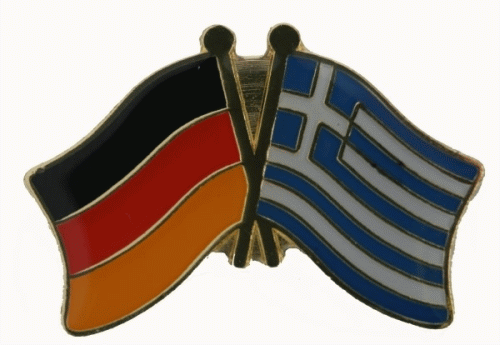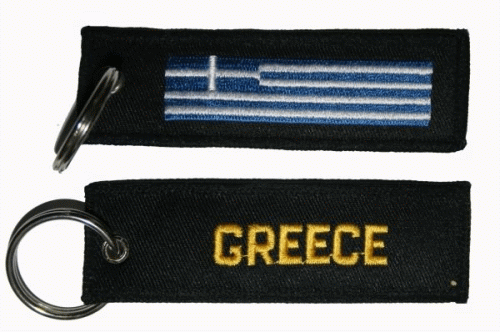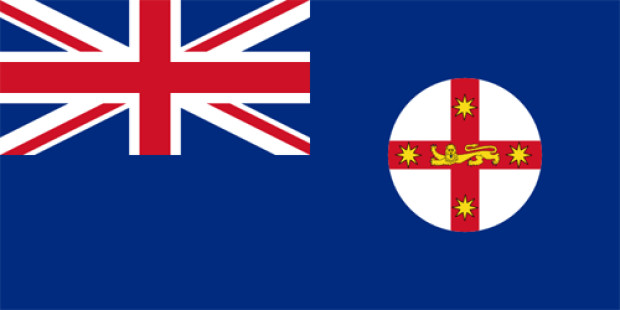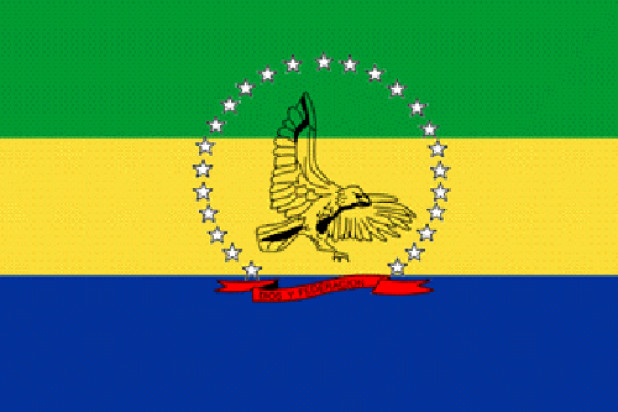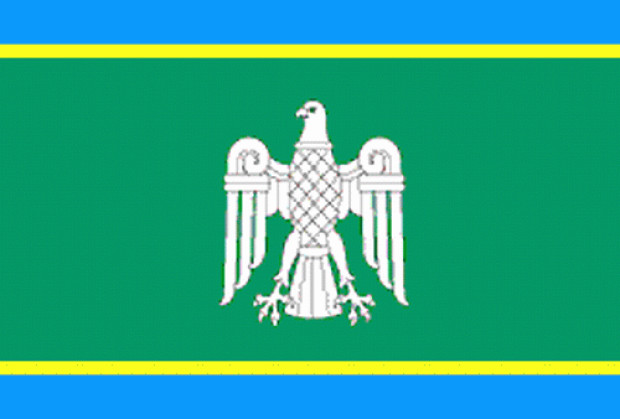Flagge von Griechenland
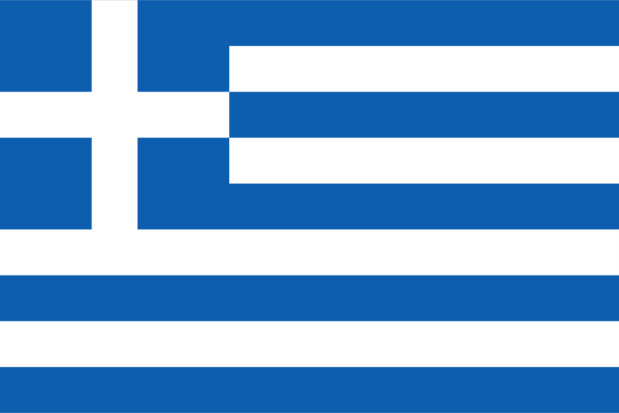
Hymne anhören
Topseller aus unserem Flaggen-Shop
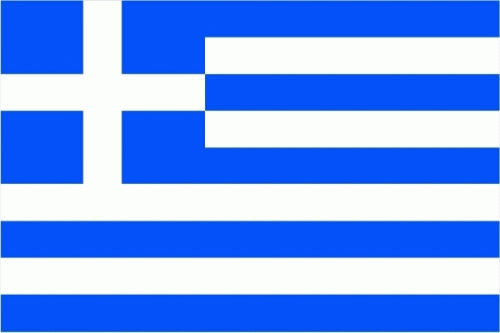
Griechenland Flagge 60x90 cm
8,90 €
Im Shop anzeigen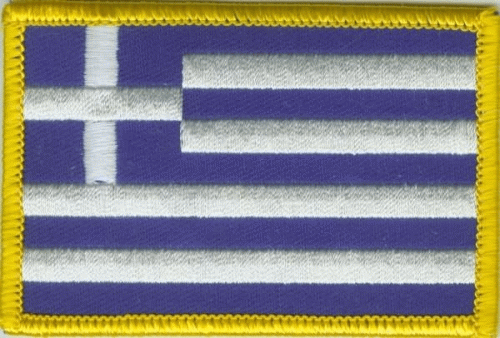
Griechenland kleine Aufnäher / Patch 4x6 cm
2,90 €
Im Shop anzeigenHintergrundwissen
The current flag of Greece stood at the history of modern Greece in constant competition with a simple blue flag with a white cross. Only in 1978 sat today's design by the only national flag in the country.
color and meaning of the Greek flag
The national flag consists of nine equally wide horizontal stripes in blue and white. In the left upper canton is a white cross on a blue is, a square base. The side of the square corresponds to the width of five horizontal stripes, white cross that has the width of this strip.
The blue and white colors can be up in the Byzantine Empire traced. The blue varied very often. During the time of King Otto I Mittelblau modeled after the crest of the Bavarian Wittelsbach was used. The Greek military junta from 1967 to 1974 used a very dark blue. The current flag is a light blue law mentioned. In most cases, we can see that the flag in an ultramarine blue, so also on the website of the Greek President.
The flag should represent "the wisdom of God, freedom and the country." The blue represents the sea and sky, white for the purity of the struggle for independence. The cross represents the Christian tradition of Greece, which is maintained primarily by the Orthodox Church. The nine stripes correspond to the nine syllables of the choice award of the Greek War of Independence: Ε-λευ-θε-ρί-α ή Θά-να-τος (E-lef-the-ri-a i Tha-na-tos, German Freedom or Death). Another explanation is that the Greek word for freedom (Ελευθερία) has nine letters. A third interpretation is that the four white stripes to the four directions and the five blue stripes correspond to the five parts of the Mediterranean seas that border the area, which in Greece on behalf of the Megali Idea 19th Century sought.
history of the Greek flag
With the Greek Revolution from 1821 to 1829 were freed the Peloponnese, Attica and the rest of Central Greece from Ottoman rule. During the struggle for independence from the Ottomans used the supporters of the family of Kolokotronis and Cypriot fighters Hadjigeorgios a blue cross on a white ground. Maybe it has already been used by the revolutionaries under Mellissinos Makarios of the 1769th The Greek guerrilla used at this time a horizontal yellow-blue-white tricolor with a white cross in the blue stripes in a laurel wreath. On 21 March 1821 began Andreas Londos, a red flag with a black, over a Latin cross with the tops turned down white crescent. The back of the flag was just red.
In January 1822 blue and white were adopted as national colors. On 27 March. (According to the Julian calendar on March 15) The flag, which is now the single national flag, served first as war maritime flag. As a war flag to land a white cross on a blue background was used, for merchant ships a blue flag was used in the Canton had a white rectangle with a blue cross .
Between 1828 and 1970 it was determined that the flag is used with the strips outside Greece and the Cross flag only domestically. The old merchant flag was abolished, civil ships used instead now the striped flag.
The Kingdom of Greece was a crown in the war and the state flag. Among the Wittelsbach kings and the Wittelsbach arms was used.
From the 18th August 1970 because of the importance of maritime Greece for the striped flag is the only national flag in the country. She had an aspect ratio of 7:12. Between June 1975 and December 1978, the cross flag for single flag, then it was again officially the striped flag. Nevertheless, the cross flag is still used by the Greek army during parades and as a symbol on their vehicles.
Hymne
Ich erkenn' dich an der Schärfe
deines Schwerts, der furchtbaren,
ich erkenn' dich an dem Blicke
der mit Kraft die Erde misst.
Von den heiligen Gebeinen
der Hellenen auferweckt
und, wie einst, nun stark geworden,
Freiheit, Freiheit, sei gegrüßt!
Dort im Grabe eingeschlossen,
eingeschüchtert und betrübt,
wartetest du auf die Stimme,
die dir sage "Komm zurück!"
Dieser Tag ließ auf sich warten,
es war alles totenstill,
alles war durch Angst verdunkelt,
Knechtschaft deckte alles zu.
Unglückliche, Trost alleine blieb
dir die Erinnerung an die längst
vergangene Größe, die erzählend du
beweinst.
Banges Harren, banges Warten
auf ein freiheitliches Wort,
schlug die eine Hand die andre
in Verzweiflung immerfort.
Und du sagtest: "Wann erhebe ich
mein Haupt aus dieser Not?"
Es erwiderten von oben Klagen,
Ketten, Jammerlaut.
Da erhobst du deine Blicke,
die vom Weinen ganz getrübt,
Blut tropfte auf deine Kleider,
vieles Blut des Griechentums.
Mit den blutigen Gewändern
stahlst du heimlich dich davon,
um zu suchen in der Fremde
andre Hände voller Kraft.
Einsam gingst du deines Weges,
einsam kehrtest du zurück,
leicht sind nicht die fremden Türen,
wenn die Not an ihnen klopft.
Rückwärts wendest du die Schritte,
bald betrittst du mit dem Fuß
jenen Felsen, jenen Rasen,
der dich an den Ruhm gemahnt.
Demütig beugt sich zu Boden
das vom Leid geprüfte Haupt,
wie des Armen, der da bettelt,
dem das Leben eine Last.
Aber jetzt stellt sich zum Kampfe
jedes Kind von dir mit Kraft,
und in rastlosem Bemühen
strebt nach Sieg es oder Tod.
Von den heiligen Gebeinen
der Hellenen auferweckt,
und, wie einst, nun stark geworden,
Freiheit, Freiheit, sei gegrüßt!
Das weiß ChatGPT zur Flagge von Griechenland
-
Die Nationalflagge Griechenlands wurde im Jahr 1978 eingeführt. Sie besteht aus einem weißen Kreuz auf blauem Grund, das auch als griechisches Kreuz bezeichnet wird. Das Kreuz symbolisiert den christlichen Glauben und die blaue Farbe steht für die griechische Seele und die Farbe des Himmels.
-
Die griechische Nationalflagge wurde 1822 während der griechischen Revolution entworfen. Sie besteht aus blau-weißen Streifen und einem weißen Kreuz auf blauem Grund. Das Kreuz symbolisiert die Religion und die blau-weißen Streifen stehen für die Seelen der Helden, die für die griechische Unabhängigkeit gekämpft haben. Die Flagge ist seitdem ein Symbol für die griechische Identität und Unabhängigkeit.
-
Die Nationalflagge von Griechenland besteht aus einem weißen Kreuz auf einem blauen Hintergrund. Das weiße Kreuz steht für die griechische Orthodoxie und das Blau für den Himmel und das Meer. Die vier Enden des Kreuzes sind in einem hellen Blauton gehalten, der an die Farben der griechischen Flagge erinnert.
Entdecken Sie etwas Neues
Zufällige Flaggen aus unserer großen Flaggendatenbank. Lassen Sie sich überraschen.
